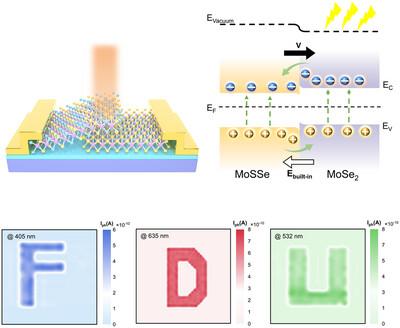Self-Powered MoSSe/MoSe2 Alloy-Heterojunction Photodetector via Interface Engineering for Dual-Function Imaging and Cryptographic Data Transmission
IF 10
1区 物理与天体物理
Q1 OPTICS
引用次数: 0
Abstract
Despite being key materials for overcoming limitations in traditional optoelectronic technologies, 2D transition metal dichalcogenides (TMDs) still face challenges due to intrinsic defects that hinder carrier transport, making interfacial modulation essential for enhancing photovoltaic performance. In this study, MoSSe/MoSe2 van der Waals heterojunction photodetectors with type-II band alignment are constructed through a combined strategy of alloying and heterojunction energy band modulation. The built-in electric field formed at the heterojunction interface significantly enhances the photoelectric conversion efficiency of the device, achieving an external quantum efficiency (EQE) of up to 470% under 550 nm illumination. Under zero bias, the device exhibits excellent self-powered performance, with an ultra-low dark current of 5 × 10−15 A, a high specific detectivity of 2.4 × 109 Jones, and an ultra-broadband spectral response ranging from 200 to 1000 nm. Furthermore, the detector demonstrates considerable potential for applications in cryptographic data transmission and sensitive multi-wavelength imaging. This work provides new insights into the study of 2D TMDs alloys and the design of high-performance photodetectors, highlighting their applicability in optical communications, imaging, and sensing.

基于接口工程的自供电MoSSe/MoSe2合金异质结光电探测器双功能成像和加密数据传输
尽管是克服传统光电技术局限性的关键材料,但由于固有缺陷阻碍载流子传输,2D过渡金属二硫族化合物(TMDs)仍然面临挑战,使得界面调制对于提高光伏性能至关重要。在本研究中,通过合金化和异质结能带调制相结合的策略,构建了具有ii型带对准的MoSSe/MoSe2范德华光电探测器。在异质结界面处形成的内置电场显著提高了器件的光电转换效率,在550 nm照明下实现了高达470%的外量子效率(EQE)。在零偏置下,该器件表现出优异的自供电性能,具有5 × 10−15 A的超低暗电流,2.4 × 109 Jones的高比探测率,以及200 ~ 1000 nm的超宽带光谱响应。此外,该探测器在加密数据传输和敏感的多波长成像方面显示出相当大的应用潜力。这项工作为二维TMDs合金的研究和高性能光电探测器的设计提供了新的见解,突出了它们在光通信、成像和传感方面的适用性。
本文章由计算机程序翻译,如有差异,请以英文原文为准。
求助全文
约1分钟内获得全文
求助全文
来源期刊
CiteScore
14.20
自引率
5.50%
发文量
314
审稿时长
2 months
期刊介绍:
Laser & Photonics Reviews is a reputable journal that publishes high-quality Reviews, original Research Articles, and Perspectives in the field of photonics and optics. It covers both theoretical and experimental aspects, including recent groundbreaking research, specific advancements, and innovative applications.
As evidence of its impact and recognition, Laser & Photonics Reviews boasts a remarkable 2022 Impact Factor of 11.0, according to the Journal Citation Reports from Clarivate Analytics (2023). Moreover, it holds impressive rankings in the InCites Journal Citation Reports: in 2021, it was ranked 6th out of 101 in the field of Optics, 15th out of 161 in Applied Physics, and 12th out of 69 in Condensed Matter Physics.
The journal uses the ISSN numbers 1863-8880 for print and 1863-8899 for online publications.

 求助内容:
求助内容: 应助结果提醒方式:
应助结果提醒方式:


